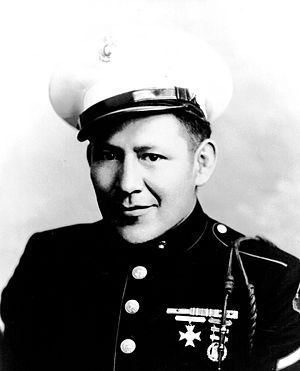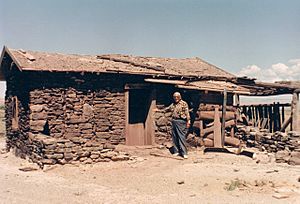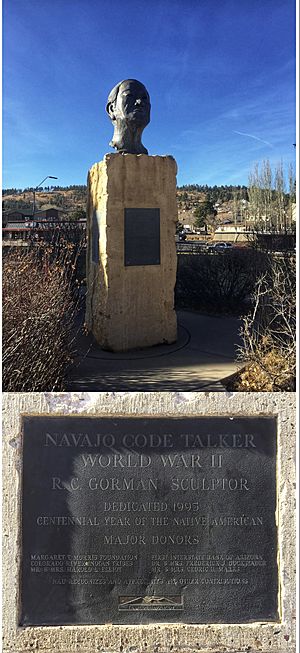Carl Nelson Gorman facts for kids
Quick facts for kids
Carl Nelson Gorman
|
|
|---|---|

Gorman in his uniform (between 1943 and 1945)
|
|
| Born |
Kin-Ya-Onny-Beyeh
October 5, 1907 Chinle, Arizona, U.S.
|
| Died | January 29, 1998 (aged 90) Gallup, New Mexico, U.S.
|
| Resting place | Family Cemeteries, Apache County, Arizona, U.S. |
| Monuments | C.N. Gorman Museum (1973) at University of California, Davis |
| Nationality | Navajo Nation, United States |
| Other names | Carl Gorman |
| Alma mater | Otis College of Art and Design |
| Occupation | code talker, soldier, painter, illustrator, printmaker, professor, healer |
| Spouse(s) | Adele Katherine Brown, Mary Excie Wilson (m.195 |
| Children | 5, including R.C. Gorman |
| Signature | |
Carl Nelson Gorman (1907–1998) was a famous Navajo artist and a brave code talker during World War II. He was also known by his Navajo name, Kin-Ya-Onny-Beyeh. He taught art at the University of California, Davis, and helped create a special department for Native American studies.
Contents
Early Life and Education

Carl Nelson Gorman was born on October 5, 1907, in Chinle, Arizona. This town is near the beautiful Canyon de Chelly National Monument. He belonged to the Dibeh Łizhin (Black Sheep) clan. His mother, Alice, was a traditional weaver. She encouraged his art from a young age.
Carl first went to the Rehoboth Mission School. There, he was punished for speaking his native Navajo language. His father then moved him to the Albuquerque Indian School. Carl was very good at sports like boxing and football there. After serving in the war, he studied art at the Otis Art Institute. This school is now called Otis College of Art and Design.
A Heroic Code Talker
In April 1942, Carl Gorman joined the United States Marine Corps. He was one of 29 Navajo men chosen to create a secret code. This code was based on the Navajo language. The Japanese military could never understand it.
Navajo code talkers used this code in every major battle of the Pacific War. Carl Gorman fought in four important campaigns: Guadalcanal, Saipan, Tinian, and Tarawa. He was honorably discharged from the Marines in 1945.
Art and Teaching Career
After the war, Carl Gorman became an illustrator in Los Angeles. In 1950, he started teaching at the University of California, Davis. He taught there until 1973.
Carl Gorman was very important in starting the Native American Studies Department at UC Davis. This department, first called Tehcumseh Center, helped students learn about Native American cultures. He also helped create an art studio for Native American artists. Carl often used traditional Navajo designs in his own artwork.
Around 1973, Carl and his wife Mary moved to Gallup, New Mexico. There, he led the Navajo Arts and Crafts Guild. He also founded the Navajo Code Talkers Association. He taught classes at Diné College and the University of New Mexico-Gallup.
Key Moments in His Life
- 1941: Carl and 28 other Navajos joined the Marine Corps. They formed the first "all Navajo" platoon in Marine Corps history.
- 1944: While serving on Saipan, Carl was injured by a mortar shell.
- 1945: Carl was honorably discharged from the Marines. He received several awards for his service.
- 1964: Carl and his son, R.C. Gorman, had a special art show together. It was called "New Directions in American Indian Art."
- 1968: The secret Navajo Code was finally made public. Carl helped his son, R.C., open the Navajo Gallery. It was the first art gallery owned by a Native American.
- 1973: Carl Gorman was elected president of the Navajo Code Talkers' Association.
- 1990: The University of New Mexico gave Carl an honorary degree.
- 2001: Carl's wife, Mary, accepted a Congressional Medal for him from President George W. Bush. This honored Carl's brave service as a code talker.
Death, Honors, and Legacy
Carl Gorman passed away from cancer on January 29, 1998, in Gallup, New Mexico. His son, R.C. Gorman, became a very famous Navajo artist. His daughter, Zonnie Gorman, is a well-known historian of the Navajo Code Talkers.
In 1973, the University of California, Davis named their new art museum the C.N. Gorman Museum in his honor. Carl also donated some of his artwork to the museum. In 1995, Northern Arizona University unveiled a monument to code talkers. It was a sculpture of Carl Gorman, created by his son R.C. Gorman.
Art in Museums
Carl Gorman's artwork can be found in many museum collections. These include the C.N. Gorman Museum, the Brooklyn Museum, and the National Museum of the American Indian. The Michael Gorman Gallery in Taos, New Mexico, often shows his rare artworks.
See also


